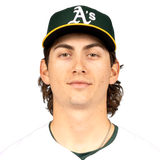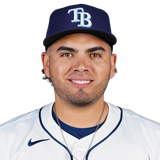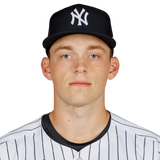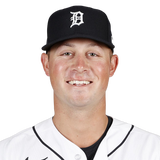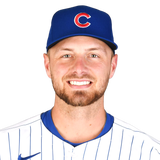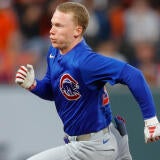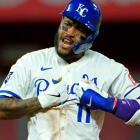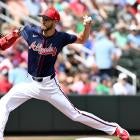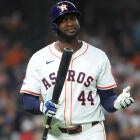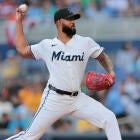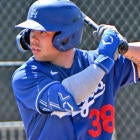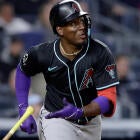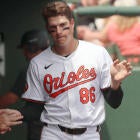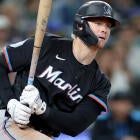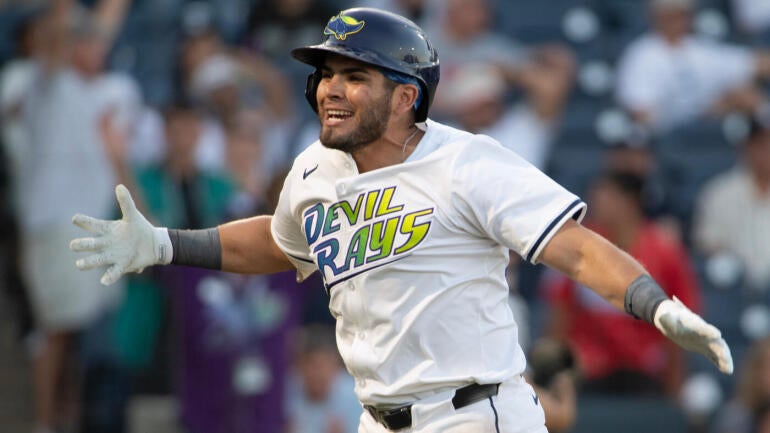
Jonathan Aranda's 2023 season belongs in the Louvre.
You're probably not familiar with it because most of it happened in the minors, so I'll sum it up for you this way: a .339 batting average, .449 on-base percentage and 25 homers in just 95 games. The slash line jumps to .376/.465/.690 over the final 58 of those games.
So what, right? Minor-league pitchers are terrible. Minor-league defenses are messy. Minor-league venues are weird. Minor-league equipment is different. Minor-league rules are ever-changing. It's not so uncommon, then, for minor-league hitters to deliver outlier stat lines without having the skills to back it up.
That's not what happened for Aranda in 2023, though. His underlying data was just as impressive as the surface-level production. His exit velocities averaged out to 92.2 mph and peaked at 113.0 mph. He walked at a 15 percent clip while striking out at just a 20 percent clip. In short, he impacted the ball like Corey Seager while possessing the plate discipline of Brandon Nimmo.
And I haven't been able to shut up about since. Aranda to me seemed like the most perfect hitting specimen you could dream up in a lab, and if he could overcome his defensive limitations and the Rays' continual roster churn to get an honest chance before he aged out of relevance, good things were sure to follow.
Following the fakeout that was 2024, a season derailed by injuries, I think everyone can acknowledge now that it's happening. His slash line is .355/.438/.677. His Baseball Savant page looks like Steve Urkel's report card. He's the most added hitter in CBS Sports leagues over the past week.
Here's the problem: He's just the latest in a procession of emergent first basemen, none of whom has taken himself out of the running at this early stage of the season. What seemed like a troublesome position on Draft Day has now become so bountiful that you may find yourself with more than you can handle. You know you have to offload one, preferably by way of trade, but how can you be sure it's the right one?
I find myself asking the same question -- and in more than one league, actually -- so if you came here looking for crystal-clear answers, I'm sorry. Life isn't that easy. What makes this particular situation so challenging is that I can't automatically rule out any of Tyler Soderstrom, Aranda, Ben Rice, Spencer Torkelson, Michael Busch or Kyle Manzardo. All are young hitters of some pedigree. None has any glaring red flags. Any of them could legitimately be this good, yet it's unlikely all of them will be.
Of course, you might think Matt Mervis deserves a mention here, too, but ... nah. So I guess that makes one I'm dismissing out of hand.
As for the six in question here -- Soderstrom, Aranda, Rice, Torkelson, Busch and Manzardo -- I can at least offer my thoughts on each. And, yes, I've listed them in the order I "rank" them, but with the caveat that I've changed my mind several times just in the past couple weeks.
Soderstrom has grabbed the most headlines with his league-leading home run total, which has made for the most aggressive move up my rankings, ahead of even Triston Casas. (After all, what has he proven, really?) The 66-homer pace is of course unsustainable, but broadly speaking, the power production is backed up by the exit velocities as well as the high fly-ball and pull rates. Soderstrom indeed profiles like a power hitter, in other words, and the plate discipline also shows some improvement from his past stints in the majors (not that it was ever terrible). Seeing as he just turned 23 in the offseason, his breakthrough this year follows a more natural trajectory than some of those mentioned here.
| ||||||||||||
My biggest concern for Aranda coming into the year was that the Rays wouldn't give him an honest look, but that concern already seems to be ill-founded. It helped that the opposing pitcher in nine of their first 10 games threw right-handed, allowing Aranda to gain a foothold over his platoon partner, Curtis Mead, whose own struggles have all but eliminated him from contention. You can never be too sure with the Rays, of course, but Aranda has gone from starting against none of the first four left-handers they faced to starting against each of the last two. He batted third against the latest one Sunday and was the only Rays batter to reach base twice in that game. Aranda's superior plate discipline makes him Soderstrom's rival in terms of pure skill, but the lingering platoon question, while trending the right way, keeps him trailing for now.
| ||||||||||||
Primarily a catcher in the minors, Rice actually has the least prospect pedigree of this group, never appearing on any major publication's top-100 list. But when you look at his minor-league production -- he slashed .324/.434/.615 between three stops in 2023 and .273/.400/.568 between two stops last year -- it's reasonable to ask why. A lack of skill? You'd be hard-pressed to make that case now. He repeatedly set new highs for exit velocity this spring and has already hit a ball 113.2 mph this season, 2.5 mph harder than any other we have on record. His swing is geared for pull-side power, which is ideal for a left-handed hitter at Yankee Stadium, and his plate discipline is such that manager Aaron Boone has taken to batting him leadoff against righties. Rice still sits against some left-handers, and there may be further playing-time complications once Giancarlo Stanton is healthy, but he looks legit to me.
| ||||||||||||
Torkelson's 2023, when he hit 31 homers and drove in 94 runs, represents the most success any of these six have had in the majors, and his 2024, when he slumped to .219/.295/.374 and spent roughly half the season in the minors, represents the most dismal failure. The Tigers all but declared they were turning the page on him in the offseason, anointing Colt Keith as their starting first baseman instead, which seemed like an outrageous concession given that they used the top pick in the 2020 draft on Torkelson. But the 25-year-old won a roster spot with a big spring performance and quickly reclaimed starting first base duties, mashing all the while. The strikeout rate has at times verged on 30 percent, which would be a real hazard to his batting average, and since we've seen it bring him down before, that has to be in the back of your mind. But there are at least no platoon concerns for him, as long as he keeps performing.
| ||||||||||||
Manzardo is the only one of these six who's had a chance to cool down already, his batting average briefly dipping below the Mendoza Line last week, but he's back in the running with a couple home runs over the weekend. He came within a single of the cycle on opening day, with all three of his extra-base hits coming off a different left-hander. That success against same-handed pitchers -- he's hit four of his six home runs against them -- has been the most fascinating part of his season and, of course, removes the platoon concern that lingers for so many of these others. Manzardo is also extremely patient at the plate and fly ball-oriented with his swing, both of which are normally plusses, but he does both to such excess that it may be working against his batting average. He's also a little light on raw power, having yet to hit a ball as hard as 110 mph as a major-leaguer.
| ||||||||||||
Busch had a reasonable enough showing as a rookie, batting .248 with 21 homers and a .775 OPS, but seeing as he was 26 at the time and seemingly confined to a platoon role, continued growth didn't seem to be in the cards for him. And maybe it still isn't. He did hit .328 with six homers and a 1.062 OPS in his first 19 games last year, after all, only to cool off from there, but I'm seeing more sustainable signs this year. He's so far shaved five percentage points off his strikeout rate from a year ago, and he's hitting a much higher percentage of fly balls to his pull side rather than the opposite field, which is what he'll need to do for his power to play up. He may, however, have the plainest platoon concerns of these six, having yet to start against a lefty this season.
| ||||||||||||
![[object Object] Logo](https://sportshub.cbsistatic.com/i/2020/04/22/e9ceb731-8b3f-4c60-98fe-090ab66a2997/screen-shot-2020-04-22-at-11-04-56-am.png)


